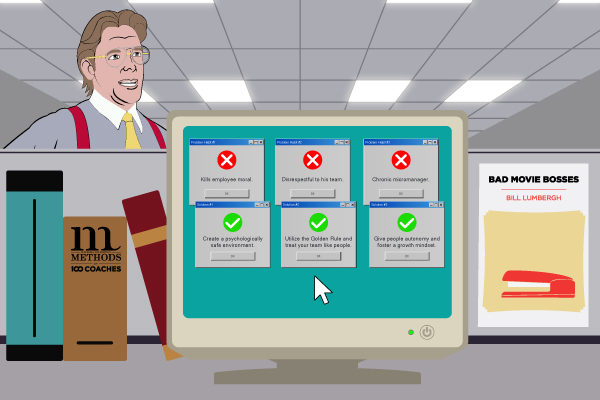If you think back to a time in school when, tasked with a group project, someone in your group ended up taking on the role of “leader” whether they were asked to or not. They may have done more work than anyone else, or they may have directed the efforts of everyone else on the team. These are often the “go-getters,” or, in more pejorative language used in the schoolyard—the teacher’s pets. Without realizing this, we’ve designated them as “informal leaders,” which is something encountered not only in school but also in the workplace. In fact, it’s an extremely common work phenomena: one person on a team ends up being the point person for the entire team, either through a show of extreme determination, high output, or budding leadership skills (or all of the above). They also probably exhibits signs of possessing a naturally generous spirit, and easily give to others; they hold a deep-seated desire to see the company do well and believe in its mission; they’re preternaturally talented in the “soft” skills (people skills); they’re good listeners and always give people the floor when needed, both because of a respect for that other person and because they know that other people can present solutions that they’d never have dreamed up themselves. In short, they exhibit all of the traditional qualities of a good leader, just without the title.
According to Indeed.com:
“Informal leadership refers to an individual’s ability to be perceived as a leader because of their reputation, credibility and influence in the workplace. Individuals within an organization view informal leaders as worthy of following or listening to. While informal leaders don’t hold a position of power within their organization and don’t control who follows them, they can still influence those around them. Their ability to lead is based on the level of respect, confidence and trust others in the workplace place on them. Their ability to wield influence comes from them helping their peers reach their goals and satisfying their needs.”
Sometimes, these people are unofficially appointed by bosses and managers, but more often than that these people seem to arise naturally out of their talents and abilities, and other people tend to take notice. If you asked most teams today, it’s likely that each of them could quite easily point to their “informal leader,” but in some cases, the lines of influence aren’t always that clear. To gauge if someone on your team is an informal leader, consider these questions:
- Does this person take on extra work outside of their assigned tasks to help improve the organization?
- Does this person often unofficially handle personnel issues, such as interpersonal conflict and disagreement?
- Does this person, knowingly or not, often mentor and help others without being asked?

If the answer to any of those is “yes” then you definitely have an informal leader on your team. So, what happens when people rely too heavily on informal leaders? Well, the same thing that can happen with formal leaders—or anyone for that matter: they get burnt out, and end up doing a poor job and potentially lowering morale. While informal leaders can help streamline teams and offer natural points of contact to higher-ups needing to connect with direct reports, a lack of compensation (both monetarily and in title) for these extra duties presents an undue burden on the shoulders of the informal leader. Here are some steps to take to make sure that you can encourage a healthy amount of informal leadership without exhausting or otherwise burning out what may just be your top people.

1. Lessen their workload. This may seem too easy, but it can really help. If someone on your team, or one of your direct reports, is taking on more informal leadership tasks outside of their title and role, take something else off their plate. Chances are there is at least some daily small task or recurring item that could be given to someone else, so that this informal leader can focus better on leading while still having some normal, role-related tasks.
2. Create a pipeline. It probably goes without saying that a natural progression from informal leadership would be that of formal leadership, and that’s certainly true judging from the data. People who demonstrate natural leadership capabilities, or take on extra responsibility unprompted by their managers are going to be “in the hat” for the next formal leadership opening, which is why planning a succession pipeline, including building in multiple informal leaders, is key. Essentially, this means that you should never have just one informal leader—have multiple, so that when inevitably one of the informal leaders moves up the ladder, there will be someone there to take their place.

3. Provide coaching and learning opportunities. Being an informal leader can be a great training ground for formal leadership positions, so bosses and managers should take every opportunity to properly train these future leaders in the skills needed to succeed. This can be done through 1:1 mentorship or through any of the myriad online leadership training platforms available, such as Methods of 100 Coaches.
4. Take care of your people. This one is simple, but so incredibly effective. Start with just paying attention to your people, especially those informal leaders whom you see breaking their backs daily over the work and all their informal, extra responsibilities. Do they seem tired? Overworked? Exhausted? Give them time off, or find someone else on the team to help share that informal leader workload. Don’t let them suffer! If they do, they’ll feel under-appreciated and likely want to leave your company. Then you’re out both an informal leader and a potential future leader.

With the pandemic causing many organizations to struggle with personnel, remote management, and unforeseen challenges, we saw a huge rise in informal leadership all around the globe as employees often stepped up to take on heavier workloads in order to see their company through tough times. The ugly side to this is that people, working from home for the first time, often felt that they needed to over-produce in order to ‘show’ their companies that they were actually working while at home, and not just doing their laundry and watching Netflix. These people, who became informal leaders whether or not they knew it, are now burned out and feeling more despondent than ever. By adopting the tips outlined above, hopefully we can all avoid another case of burnout.





